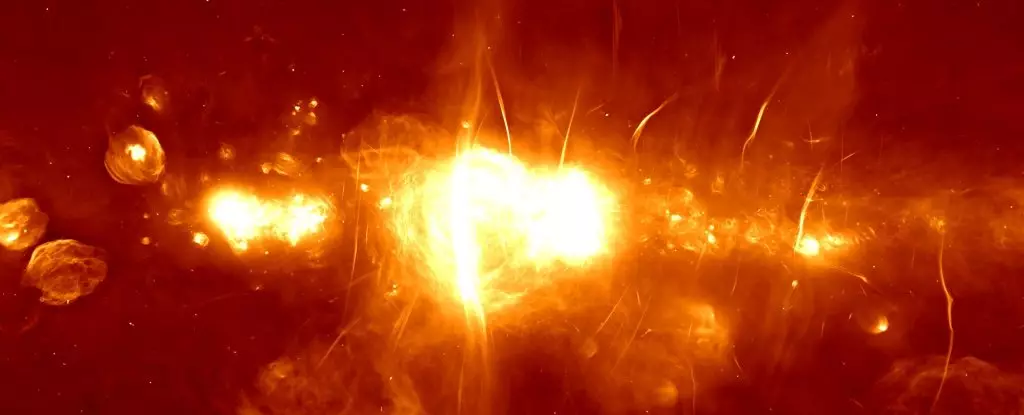The Milky Way’s galactic center, a swirling mass of gas, dust, and dark matter, is one of the most enigmatic regions in our universe. Bursting with dynamic processes and extreme conditions, this part of our galaxy encapsulates a fertile yet chaotic environment. Recent findings led by astronomers at Shanghai Jiao Tong University have illuminated a new facet of this cosmic tapestry. They’ve uncovered what they’ve dubbed “slim filaments,” peculiar structures that challenge existing understandings of material circulation around Sagittarius A*, the supermassive black hole residing at our galaxy’s core. This discovery not only deepens our comprehension of galactic dynamics but also sets the stage for new theories about gas dispersal and star formation.
Unveiling the Slim Filaments
Utilizing the Atacama Large Millimeter/submillimeter Array (ALMA) in Chile, the research team sought to scrutinize the Central Molecular Zone (CMZ), a densely packed region that accounts for about 80 percent of the galaxy’s dense gas. What they found was astonishing: long, thin filaments of gas that are spatially distinct from any known star formation regions. Unlike previously characterized cosmic structures, these slim filaments exhibit unique properties that are not only visually mesmerizing but also scientifically significant.
Upon closer inspection, astronomers identified that these filaments were composed of various complex organic molecules, including cyclopropenylidene and methanol. Their unexpected velocity distributions contrasted sharply with conventional filaments, indicating behaviors driven by turbulent pressure rather than gravitational forces. By likening these cosmic formations to tornadoes, researchers proposed that they act as conduits for material distribution throughout the turbulent galactic center.
The Enigma of Formation
While the precise origins of the slim filaments remain a mystery, the prevailing theory suggests a probable link between shock waves and turbulent gas flows generated by cosmic collisions within the CMZ. As these shock fronts encounter dense clouds, they may ignite a chain reaction that pushes complex molecules into a gaseous state, facilitating their dispersion into the interstellar medium. The cooling of these gases subsequently leads to the formation of dust, effectively fueling the material cycle within the CMZ and offering a robust mechanism for material redistribution.
Scientists speculate that if these slim filaments are as ubiquitous throughout the CMZ as their sampling indicates, they could play a vital role in the overarching recycling mechanisms of the galaxy. This potential scale of impact raises significant questions about the nature of galactic evolution and the lifecycle of matter within it.
The Galactic Center: A Laboratory of Turbulence
The CMZ is not just a region of interest for astronomers; it serves as a natural laboratory for studying turbulence at an unprecedented scale. With clouds of gas and dust barreling through space at speeds of up to 100 kilometers per second, understanding the dynamics of such a chaotic setting can shed light on fundamental astrophysical processes. The slim filaments, acting like cosmic tornadoes, pose an exciting research opportunity, unlocking newer layers of understanding about how gas behaves under extreme conditions.
This turbulent environment defies simple explanations and invites an array of questions for researchers. How do these structures influence star formation? What role do they play in galactic chemistry? And most importantly, can they help us answer the age-old question of how galaxies evolve over eons?
Implications and Future Research
The implications of these findings are vast, suggesting a revolution in how we view cosmic structures and their interplay in shaping the universe. By shifting perspectives from the traditional view of dense gas clouds to the active role of slim filaments, researchers open the door to new avenues of inquiry and exploration. The discoveries at the Milky Way’s heart not only promise advancements in our understanding of this region but challenge our conceptual frameworks regarding interstellar gas dynamics.
Future research is set to delve deeper into the CMZ, focusing on mapping the distribution and role of slim filaments throughout the galaxy. By employing advanced observational techniques and model simulations, scientists can develop a more robust understanding of their formation mechanisms and impacts on galactic evolution. The path forward is laden with both challenges and opportunities, but the excitement surrounding cosmic tornadoes could usher in a new era of astronomical discovery.
Space is vast, intricate, and steadfastly holds secrets that scientists are only beginning to grasp. As we peel back the layers of mystery surrounding the Milky Way’s core, we inch closer to answering some of the universe’s most profound questions.

